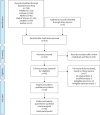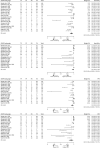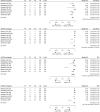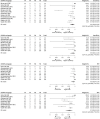Performance of saline and water gargling for SARS-CoV-2 reverse transcriptase PCR testing: a systematic review and meta-analysis
- PMID: 36130785
- PMCID: PMC9724820
- DOI: 10.1183/16000617.0014-2022
Performance of saline and water gargling for SARS-CoV-2 reverse transcriptase PCR testing: a systematic review and meta-analysis
Abstract
The performance of gargling for severe acute respiratory syndrome coronavirus 2 (SARS-CoV-2) reverse transcriptase (RT)-PCR testing has not been previously reviewed. This review systematically assessed the performance of saline and water gargling for SARS-CoV-2 RT-PCR testing in the settings of diagnosing and monitoring viral shedding.We included original studies comparing the performance of gargling and (oropharyngeal-)nasopharyngeal swabs for SARS-CoV-2 RT-PCR testing. Studies conducted in either suspected individuals or confirmed cases were included and analysed separately. The sensitivity, specificity, positive predictive value (PPV) and negative predictive value (NPV) were examined using random-effects models.Gargles achieved a high overall sensitivity (91%), specificity (97%), PPV (95%) and NPV (91%) for SARS-CoV-2 RT-PCR testing. Studies using saline gargle and water gargle have an overall sensitivity of 97% and 86%, respectively. The sensitivity values were largely maintained for saline and water gargling on stratified analysis, for both diagnosis (96% and 92%) and viral shedding monitoring (98% and 78%). A higher sensitivity was also reported by studies using sterile saline (100%), a smaller amount of gargling solution (92% versus 87%) and a longer gargling duration (95% versus 86%).Our results supported the use of gargling as a sampling approach for SARS-CoV-2 RT-PCR testing, which achieved a high sensitivity for both diagnosis and viral shedding monitoring purposes. Further investigation on the comparative performance of different gargling mediums is needed to draw a definitive conclusion.
Copyright ©The authors 2022.
Conflict of interest statement
Conflict of interest: B.J. Cowling consults for Roche and Sanofi Pasteur. All other authors declare no competing interests.
Figures




Similar articles
-
Rapid, point-of-care antigen tests for diagnosis of SARS-CoV-2 infection.Cochrane Database Syst Rev. 2022 Jul 22;7(7):CD013705. doi: 10.1002/14651858.CD013705.pub3. Cochrane Database Syst Rev. 2022. PMID: 35866452 Free PMC article.
-
Signs and symptoms to determine if a patient presenting in primary care or hospital outpatient settings has COVID-19.Cochrane Database Syst Rev. 2022 May 20;5(5):CD013665. doi: 10.1002/14651858.CD013665.pub3. Cochrane Database Syst Rev. 2022. PMID: 35593186 Free PMC article.
-
Antibody tests for identification of current and past infection with SARS-CoV-2.Cochrane Database Syst Rev. 2022 Nov 17;11(11):CD013652. doi: 10.1002/14651858.CD013652.pub2. Cochrane Database Syst Rev. 2022. PMID: 36394900 Free PMC article.
-
Thoracic imaging tests for the diagnosis of COVID-19.Cochrane Database Syst Rev. 2022 May 16;5(5):CD013639. doi: 10.1002/14651858.CD013639.pub5. Cochrane Database Syst Rev. 2022. PMID: 35575286 Free PMC article.
-
Saline gargle collection method is comparable to nasopharyngeal/oropharyngeal swabbing for the molecular detection and sequencing of SARS-CoV-2 in Botswana.Microbiol Spectr. 2025 Jul;13(7):e0202324. doi: 10.1128/spectrum.02023-24. Epub 2025 May 22. Microbiol Spectr. 2025. PMID: 40401962 Free PMC article.
Cited by
-
Recent advances in RNA sample preparation techniques for the detection of SARS-CoV-2 in saliva and gargle.Trends Analyt Chem. 2023 Aug;165:117107. doi: 10.1016/j.trac.2023.117107. Epub 2023 May 23. Trends Analyt Chem. 2023. PMID: 37317683 Free PMC article. Review.
-
The effect of sample site and collection procedure on identification of SARS-CoV-2 infection.Cochrane Database Syst Rev. 2024 Dec 16;12(12):CD014780. doi: 10.1002/14651858.CD014780. Cochrane Database Syst Rev. 2024. PMID: 39679851 Free PMC article.
References
-
- World Health Organization . Weekly epidemiological update on COVID-19 – 6 July 2021. www.who.int/publications/m/item/weekly-epidemiological-update-on-covid-1... Date last updated: 6 July 2022. Date accessed: 4 August 2022.
-
- World Health Organization . Weekly epidemiological update on COVID-19 – 11 January 2022. www.who.int/publications/m/item/weekly-epidemiological-update-on-covid-1... Date last updated: 11 January 2022. Date accessed: 4 August 2022.
-
- World Health Organization . Laboratory Testing for Coronavirus Disease (COVID-19) in Suspected Human Cases: Interim Guidance, 19 March 2020. World Health Organization, Geneva; 2020.
-
- Centers for Disease Control and Prevention . Interim guidelines for collecting and handling of clinical specimens for COVID-19 testing. www.cdc.gov/coronavirus/2019-nCoV/lab/guidelines-clinical-specimens.html Date accessed: 7 June 2021. Date last updated: 15 July 2022.
Publication types
MeSH terms
Substances
LinkOut - more resources
Full Text Sources
Medical
Miscellaneous
